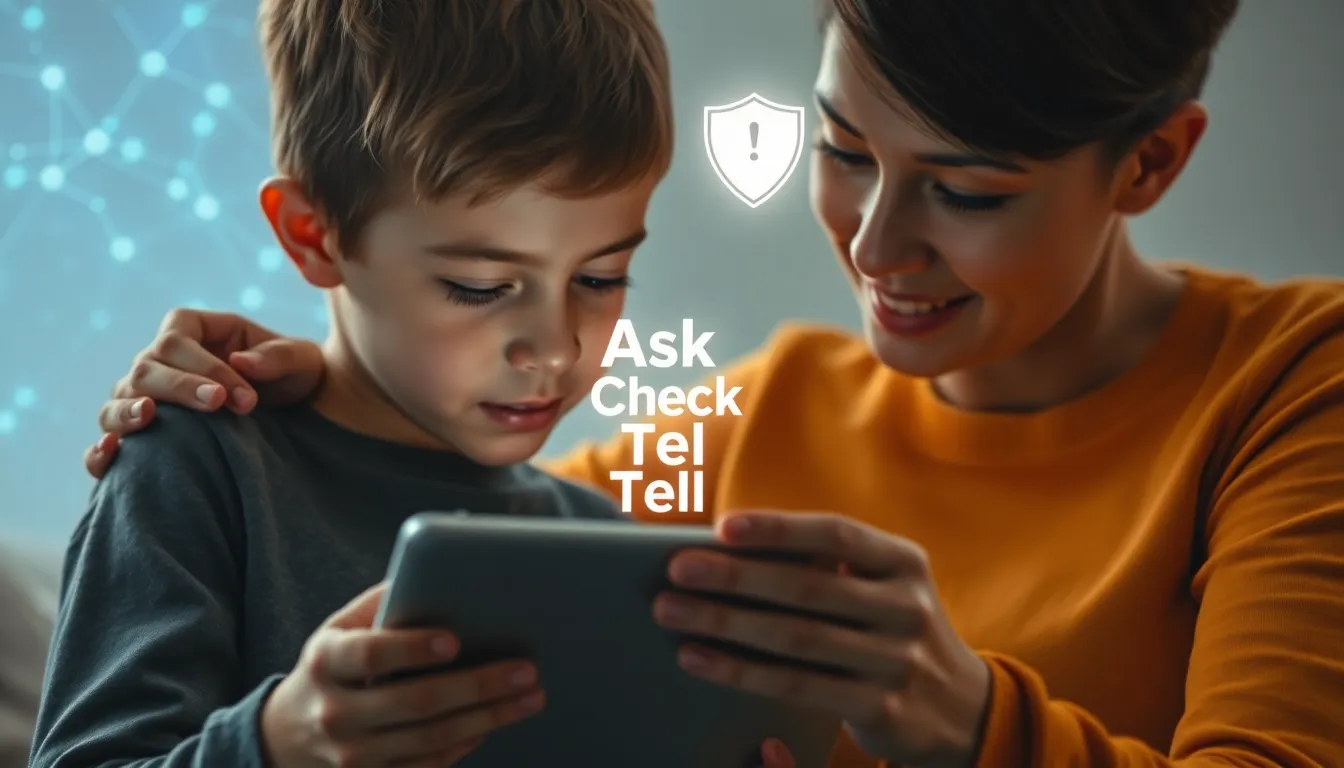Online grooming attempts affect 1 in 5 children, highlighting the urgent need for parents to understand how to talk to kids about online grooming prevention. Despite this escalating threat, a significant gap exists in parental confidence and crucial conversations, leaving many children vulnerable to sophisticated digital predators.
Key Implications
- Pervasiveness of Online Grooming: Online grooming is a widespread threat, with 1 in 5 children aged 8-17 experiencing attempts, and 40% of victims being under 10, underscoring the necessity for early and consistent parental guidance.
- Impact of Parental Communication: Children with frequent, open conversations about online safety are 30% less likely to encounter risky situations, yet only 48% of parents feel confident in their ability to protect children online, and 45% have initiated specific prevention talks.
- Grooming Playbook and Vulnerable Platforms: Grooming typically unfolds over 3-6 months on platforms like social media (60%) and gaming (25%), moving beyond “stranger danger” to involve manipulative trust-building tactics.
- Empowering Children with Actionable Strategies: Teaching children the “Ask, Check, Tell” approach increases their likelihood of reporting suspicious activity by 25%, while effective application of privacy settings, understood by only 40% of 8-12-year-olds, and a “no secrets” policy are crucial defenses.
- Utilizing Expert-Vetted Resources: Programs like NetSmartz (reaching over 10 million children) and Common Sense Media (supporting 50 million families annually) offer structured guidance, age-appropriate educational tools, and updated information to empower parents in online safety efforts.

1 in 5 Kids Face Online Grooming Attempts: Why Your Conversations Matter More Than Ever
The digital landscape, while offering incredible opportunities, harbors an alarming and escalating threat: online grooming. This pervasive danger impacts countless young lives, with recent data painting a stark picture of its widespread reach. In 2022 alone, authorities received 32.5 million reports of suspected child sexual exploitation, a staggering 88% of which involved online platforms, underscoring the internet’s critical role in these illicit activities.
Even more concerning is the direct impact on children. Statistics reveal that 1 in 5 children, or 20% of those aged 8-17, have reported an attempted online grooming incident. This highlights a significant and immediate risk for a substantial portion of our youth. Tragically, the vulnerability extends to very young children, as 40% of online grooming victims are under the age of 10, emphasizing the urgent need for parents to understand how to talk to kids about online grooming prevention from an early age.
The Disturbing Scope and Youngest Victims of Online Grooming
The scale of online grooming is immense, far exceeding what many parents might realize. The sheer volume of 32.5 million reports in a single year, predominantly linked to online interactions, demonstrates a sophisticated and persistent threat. These incidents often leverage children’s access to social platforms, gaming communities, and various online communication channels, making vigilance paramount. For parents seeking guidance, understanding safe social media use guidelines for teenagers is a crucial starting point, even if their children are younger, as the principles often apply broadly.
The fact that 1 in 5 children aged 8-17 have encountered grooming attempts should serve as a wake-up call for every parent. This isn’t a rare occurrence but a tangible risk that necessitates proactive engagement. The statistic that 40% of victims are under the age of 10 is particularly harrowing. It signifies that children, even before they fully comprehend complex social dynamics, are targets, making early, age-appropriate conversations on how to talk to kids about online grooming prevention absolutely essential for their safety.
The Untapped Power of Parental Communication in Prevention
Despite the grim statistics, there is a powerful and accessible protective factor: parental communication. Research consistently shows that children with frequent and open parental conversations about online safety are significantly better protected. Specifically, these children are 30% less likely to encounter risky online situations. This underscores the transformative impact that ongoing dialogue can have on a child’s ability to navigate the digital world safely and recognize potential threats.
These conversations are not about instilling fear but about empowering children with knowledge and resilience. By creating an environment where children feel safe to share their online experiences without judgment, parents can build a crucial line of defense. Discussions should cover what constitutes inappropriate behavior, the importance of privacy, and how to identify red flags. Furthermore, understanding signs of cyberbullying in middle schoolers can help parents recognize broader online risks that may sometimes intersect with grooming tactics.
Bridging the Confidence and Communication Gap
While the protective role of parents is clear, a significant gap exists in confidence and proactive communication. Current data indicates that only 48% of parents feel “very confident” in their ability to protect their children online. This lack of confidence can be a barrier to initiating crucial discussions, leaving many parents feeling ill-equipped to address complex digital dangers. It’s a key reason why discussions about how to talk to kids about online grooming prevention often get delayed or avoided altogether.
Furthermore, this uncertainty translates into a critical communication deficit: only 45% of parents have actually initiated specific conversations about online grooming prevention. This suggests that while parents may care deeply about their children’s safety, many are unsure how or when to start these vital dialogues. Overcoming this gap requires accessible resources, practical strategies, and a willingness from parents to step into this uncomfortable yet necessary role. Setting up safety features, such as those for YouTube Kids child safety features, can be a practical step, but these must be complemented by direct communication.
The task of how to talk to kids about online grooming prevention is multifaceted, involving ongoing education for both parents and children. It means fostering an environment of trust where children feel comfortable reporting anything that makes them feel uneasy, regardless of who is involved. Equipping parents with the tools and confidence to have these discussions openly and regularly is paramount in protecting our children from the insidious threat of online grooming.

Beyond ‘Stranger Danger’: The 3-6 Month Grooming Playbook and How Kids Can Block It
The traditional warning of “stranger danger” falls short in today’s digital landscape. Online groomers are not always easily identifiable outsiders; instead, they strategically target children on popular platforms, often spending months building trust through manipulative tactics. This subtle, long-term approach requires a modern, proactive strategy for how to talk to kids about online grooming prevention. Parents must equip their children with actionable safety strategies to recognize and counter these sophisticated methods.
Understanding the Online Grooming Playbook
The grooming process is a deliberate and patient game, typically unfolding over 3 to 6 months as groomers build trust. They begin by establishing a seemingly innocent connection, often through shared interests like gaming, hobbies, or popular culture. This initial phase involves flattery, constant communication, and a careful observation of the child’s vulnerabilities and needs.
These manipulative individuals gravitate towards environments where children are most active and feel safest. Statistics reveal the alarming prevalence of grooming across various digital spaces: 60% of online child sexual abuse material reports linked to grooming originated on social media platforms. Gaming platforms accounted for 25% of reports, while direct messaging applications were tied to 10%. These figures underscore the critical need for vigilance across all digital interactions, moving beyond simple “stranger danger” warnings to address the nuances of online predatory behavior.
Groomers isolate children by creating a sense of exclusive connection, encouraging them to keep conversations secret and fostering a dependency on the abuser for emotional support or validation. They might offer gifts, special attention, or unique “opportunities,” all designed to cement their position as a trusted, irreplaceable figure in the child’s life. This gradual erosion of boundaries makes it increasingly difficult for children to identify the danger, highlighting why a comprehensive approach to how to talk to kids about online grooming prevention is paramount.
Equipping Kids with Actionable Safety Strategies
Parents can proactively counter these predatory methods by equipping children with concrete, actionable safety strategies. One highly effective tool is the “Ask, Check, Tell” approach. This empowers children to: Ask questions about anything that makes them feel uncomfortable or confused; Check with a trusted adult if an interaction feels suspicious or inappropriate; and immediately Tell a trusted adult about any uncomfortable or concerning online interaction. Data shows that children taught “Ask, Check, Tell” are 25% more likely to report suspicious activity, demonstrating the power of clear, repeatable actions.
Another crucial defense is a comprehensive understanding of privacy settings. While 70% of teens aged 13-17 understand privacy settings, a significant gap exists with younger children: only 40% of 8-12 year olds effectively apply them. This disparity often stems from complex interfaces or a lack of understanding about what information is truly being shared. Parents should sit down with their children, regardless of age, to review and customize privacy settings together on all platforms, including social media apps and gaming accounts. This teaches children how to control their digital footprint and limits unwanted exposure to potential groomers. Resources on safe social media use guidelines can provide a valuable starting point for these conversations.
Finally, fostering an unwavering “no secrets” policy for uncomfortable interactions is non-negotiable. Children need to understand that 100% of uncomfortable interactions should be shared with a trusted adult. This message must be reinforced consistently, emphasizing that sharing secrets that make them feel bad or scared is never wrong and will not result in punishment. Establishing this foundation of trust encourages open communication and provides children a safe avenue to disclose disturbing online encounters. Parents can also consider using parental control apps as a supplementary tool, not a replacement for dialogue, to monitor online activities and help identify potential threats or recognizing signs of cyberbullying.
Proactive Parenting: Fostering Open Communication
Beyond setting rules, proactive parenting involves cultivating an environment of open and non-judgmental communication. Regular, calm conversations about online experiences, without invading privacy or instilling fear, are key. Ask about their favorite games, who they chat with, and what new things they’ve discovered online. These informal discussions create opportunities for children to naturally bring up concerns or strange interactions they might have experienced, making it easier for them to approach you when something truly feels off. It’s about building a partnership in online safety.
Educating children about specific online dangers, such as unsolicited friend requests, requests for personal information, or pressure to keep secrets, is also vital. Explain that online friends are not always who they claim to be and that requests for photos, videos, or meeting in person are immediate red flags. This equips them with the critical thinking skills needed to evaluate online interactions independently. Discussing practical examples of what to do in these situations, such as blocking, reporting, and immediately telling an adult, reinforces the actionable strategies.
Parental engagement also extends to being aware of the platforms children use and understanding their functionalities. Whether it’s setting up YouTube Kids child safety features or understanding the chat functions in popular online games, parents who are familiar with these environments are better positioned to guide and protect their children. This holistic approach ensures that how to talk to kids about online grooming prevention is not a one-time conversation but an ongoing dialogue supported by practical tools and a trusting family environment.

Expert-Vetted Tools: 10 Million Kids and 50 Million Families Use These Safety Resources
The digital landscape can feel vast and overwhelming for parents striving to protect their children online. Many parents believe they must navigate the complexities of digital safety alone, but this isn’t the case. A wealth of expert-developed resources exists, offering structured guidance, age-appropriate educational materials, and up-to-date information on evolving online threats. These invaluable tools provide essential support for families aiming to reinforce online grooming prevention messages effectively.
Understanding how to talk to kids about online grooming prevention is paramount, and these resources equip parents with the confidence and knowledge needed for these crucial conversations. They transform abstract concerns into actionable steps, providing clear frameworks for discussing internet safety with children of all ages. This collective expertise helps demystify online dangers, making the topic less daunting for parents and more understandable for young minds.
Empowering Families with Proven Educational Platforms
Leading organizations have invested significantly in creating accessible and impactful online safety programs. One prime example is NCMEC’s “NetSmartz” initiative. This program stands out for its comprehensive approach, utilizing interactive videos, games, and activities to educate children and adults alike. NetSmartz has effectively reached over 10 million children and adults, empowering them with critical knowledge about staying safe online. Its success lies in translating complex safety concepts into engaging content that resonates with various age groups, from preschoolers to teenagers.
Similarly, Common Sense Media serves as another cornerstone for digital parenting. This organization provides trusted reviews of apps, games, movies, and websites, alongside practical advice for families. Their extensive library helps parents make informed decisions about the digital content their children consume and interact with. The impact is far-reaching, with Common Sense Media supporting more than 50 million families annually in their quest to navigate the digital world safely. Their resources are pivotal in guiding parents on age-appropriate discussions and recognizing potential risks, thereby strengthening their ability to implement effective online grooming prevention strategies.
Structured Guidance for Proactive Protection
The structured guidance offered by these expert-vetted tools goes beyond simple warnings; it provides concrete strategies for families. Parents can access conversation starters designed to facilitate open dialogue with their children about online interactions, stranger danger, and privacy settings. These tools also frequently include templates for family media agreements, helping establish clear expectations and boundaries for device use and online behavior. This proactive approach is crucial when considering how to talk to kids about online grooming prevention, shifting the focus from fear to informed decision-making and digital citizenship.
Many resources delve into specific areas, such as creating safe social media habits. For instance, understanding safe social media use guidelines for teenagers is vital in an age where online platforms are central to peer interaction. These guidelines help parents set boundaries and teach their teens to recognize and report inappropriate content or contact. Such detailed guidance ensures that safety conversations are not abstract but grounded in the realities of children’s online experiences, addressing real-world scenarios they might encounter.
Staying Ahead of Evolving Online Threats
The internet is constantly changing, with new apps, platforms, and potential threats emerging regularly. Expert resources are continuously updated to reflect these changes, providing families with the most current information available. This includes insights into emerging online grooming tactics and how to identify and respond to them. Parents can find information on recognizing signs of cyberbullying in middle schoolers, a crucial aspect of overall online safety that often intersects with grooming behaviors, as bullies can sometimes be groomers or pave the way for them.
Beyond identifying threats, these platforms offer practical solutions, such as guidance on setting up robust privacy settings and utilizing parental controls. Resources might detail setting up YouTube Kids child safety features to ensure content remains age-appropriate, or recommend top parental control apps that can monitor activity and filter inappropriate content. These tools are not meant to replace open communication but to complement it, offering an additional layer of protection and peace of mind. By staying informed through these expert channels, parents can maintain a robust defense against online dangers and consistently reinforce messages about how to talk to kids about online grooming prevention effectively, ensuring their children’s digital safety remains a top priority.
Featured image generated using Flux AI
Source
National Center for Missing and Exploited Children (NCMEC) – CyberTipline 2022 Statistics Report
NSPCC – Online Safety Report 2023: Tackling Online Grooming
Internet Watch Foundation (IWF) – Online Child Sexual Abuse Trends Report 2023
Family Online Safety Institute (FOSI) – The Power of Parental Engagement: Online Safety Study 2022
Pew Research Center – Parenting in the Digital Age: Concerns and Confidence 2023
FBI – Internet Crime Report 2023
Common Sense Media – Digital Media and Your Child Report
Thorn – Impact Report
